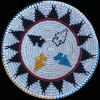Anasazi houses
Large ruins, generally located in defensible areas such as cliff faces or on mesa tops and that were ancestrally occupied by the Anasazi.
In contemporary scholarship, the Anasazi are also referred to as Ancient or Ancestral Pueblo peoples. This ancient Native American culture was concentrated in the Four Corners area of the Southwest, including the present day states of Utah, Colorado, New Mexico, and Arizona. Ancestral Puebloans are known for the range of structures they left behind, especially their cliff dwellings, inclulding those found in Many Ruins Canyon (Canyon de Chelly), Chaco Canyon, and Mesa Verde National Park. The term “pueblo” is both the name given to the culture and the name of their dwellings and was given to the culture by the Spanish, who recognized in these site buidling styles and a social organization of space similar to the "pueblos" or villages they had left behind on the Iberian Peninsula.










